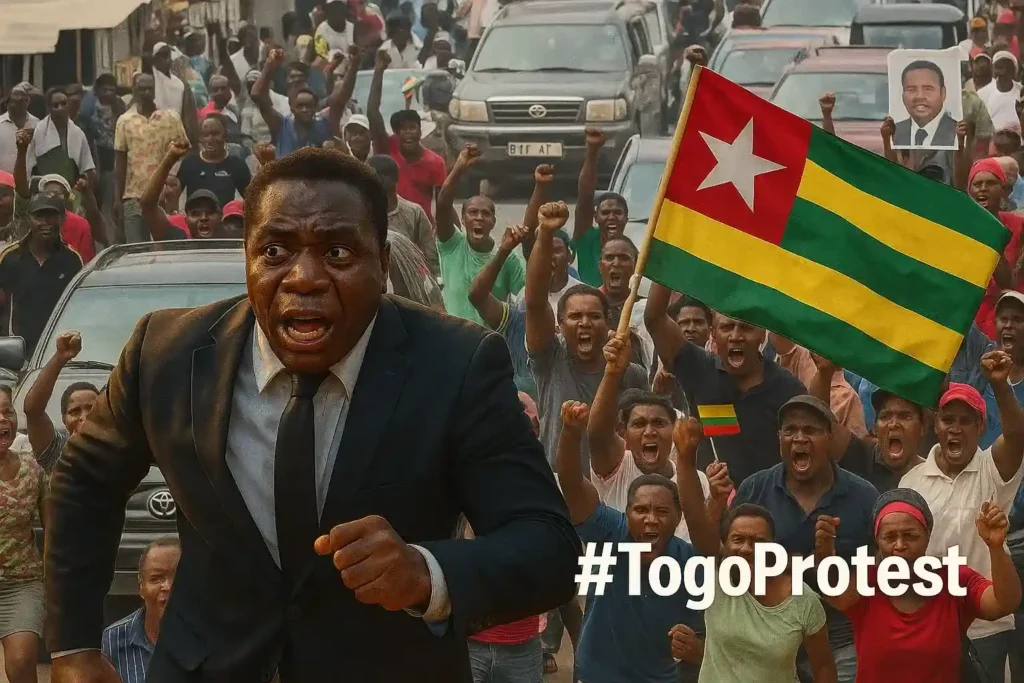From Nairobi to Lome, a shared unrest unfolds citizens rising against corruption, repression, and deepening poverty. In Togo, June 2025 protests exposed public anger at Faure Gnassingbé’s power extension, economic hardship, and shrinking freedoms. Youth-led and non-partisan, the movement reflects a wider demand for accountable governance.
Background of Togo Protest
Togo, a small country in west Africa rich in resources and featuring beautiful coastal plains, has been ruled by the Gnassingbe family for over five decades. In early 2025, President Faure Gnassibe, who took office in 2005 after the death of his father Gnassingbe Eyadema, proposed constitutional amendments that would allow him to extend his term in office indefinitely, a move made without broad-based consultation and contrary to “democratic” norms. This development has sparked widespread discontent among the Togolese people, who feel betrayed and failed by the regime. At present, the streets of Lome are filled with youths expressing their frustration with the regime’s policies, which have perpetuated poverty, tolerated corruption, and hindered small businesses and entrepreneurship. Political oppression and media censorship have further exacerbated the situation, prioritizing western interests over the needs of the Togolese and led to serious Protest at Togo.
Causes of the Protest
The June 2025 protests in Togo were triggered by several controversial key issues. In 2024, Faure Gnassingbe gave sweeping powers to himself by changing Togo’s constitution, that is weakening the Presidency and creating a powerful new role the president of the council of ministers, which will be chosen by the parliament. In simple terms President Faure rewrote the rules, gave all the power to a new post called President of the Council of Minister, and put himself in that post.
These constitutional changes and Power Consolidation were heavily accused by opposition groups calling it a “constitutional coup”, a manipulating system to extend the rule and exploit power. Tensions escalated after the arrest of rapper Aamron and poet Affectio who had called for protests against the rule and criticisms against the government through social media. Since 2022, public protests have been banned, with the government citing security threats. Civil liberties have sharply declined, with media censorship, arbitrary arrests, internet shutdowns becoming International media like RFI and France 24 faced suspensions. Journalists were harassed and protest footage was forced to be deleted. Rising fuel and electricity costs, high youth unemployment, and a deepening cost-of-living crisis added to public anger and is seen as a sign of authoritarianism.
Timeline of the Protest in Capital Lome
June 5–6
The arrest of rapper Aamron and the release of a troubling videoapologizing to Gnassingbé from a psychiatric hospital in Zebe, where he was reportedly held for “severe depression”. Youth-led civil groups, operating outside the influence of traditional political parties, organized protests through platforms like TikTok, rallied in various parts of Lome, calling out the government’s handling of dissent, worsening living conditions, and the recent constitutional amendments. Security forces responded with force deploying tear gas, arresting nearly 80 people, and detaining journalists and making them erase Protest footage.
June 9
In a public statement, Prosecutor Talaka Mawama announced the release of 56 protesters, citing minor charges. However, the framing of the demonstrations as a “revolt against state institutions” suggested a hardening government position. Amnesty International released findings that several detainees had suffered physical abuse, with medical reports confirming injuries such as bruises, contusions, and restricted movement.
June 26–28
Tensions reignited as the “Hands Off My Constitution” coalition of political groups called for nationwide demonstrations over three days 26,27,28 June 2025. Demands included President Gnassingbé’s resignation, the release of political detainees, and urgent economic relief. Protests in Lome grew more confrontational, with barricades, tire fires, and clashes between civilians and Police.
Social media reports indicated that security forces, overwhelmed, resorted to using stones after tear gas supplies were exhausted. Markets were shuttered, daily life disrupted, and the capital bore the marks of a society in deep distress. These protests were no longer only about power but about dignity, frustration, and the rising cost of being unheard. Several footage circulating in Social Media Platforms show that the Togolese government paid 150,000 CFA francs to local goons to attack anti government protestors. They were recruited from poor communities, used to intimidate, injure, and disperse the protestors.
Analyzing the Togo Protest 2025
Togo’s 2025 youth-led protests echo the 2017–2018 nationwide unrest, both driven by opposition to constitutional changes aimed at extending President Gnassingbé’s rule. In both cases, the regime responded with internet shutdowns, arrests, tear gas, and reports of torture. The protests in Togo highlight an evolving form of civic resistance that is increasingly visible across several African countries. In response to their continued exclusion from political and economic structures, young people—who are mainly disengaged from traditional political parties are now spearheading movements. In Togo, President Faure Gnassingbé’s constitutional reform was a calculated expansion of his personal control rather than a step toward democracy. Chronic unemployment, deteriorating access to essential services, and limitations on civil liberties have all contributed to public annoyance.

